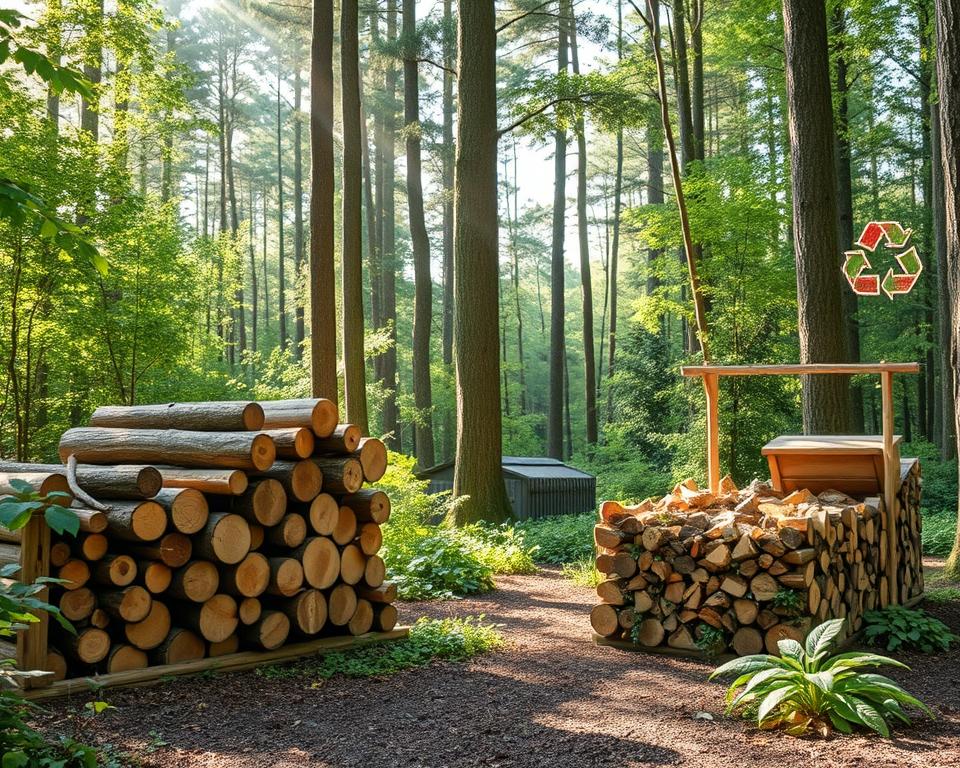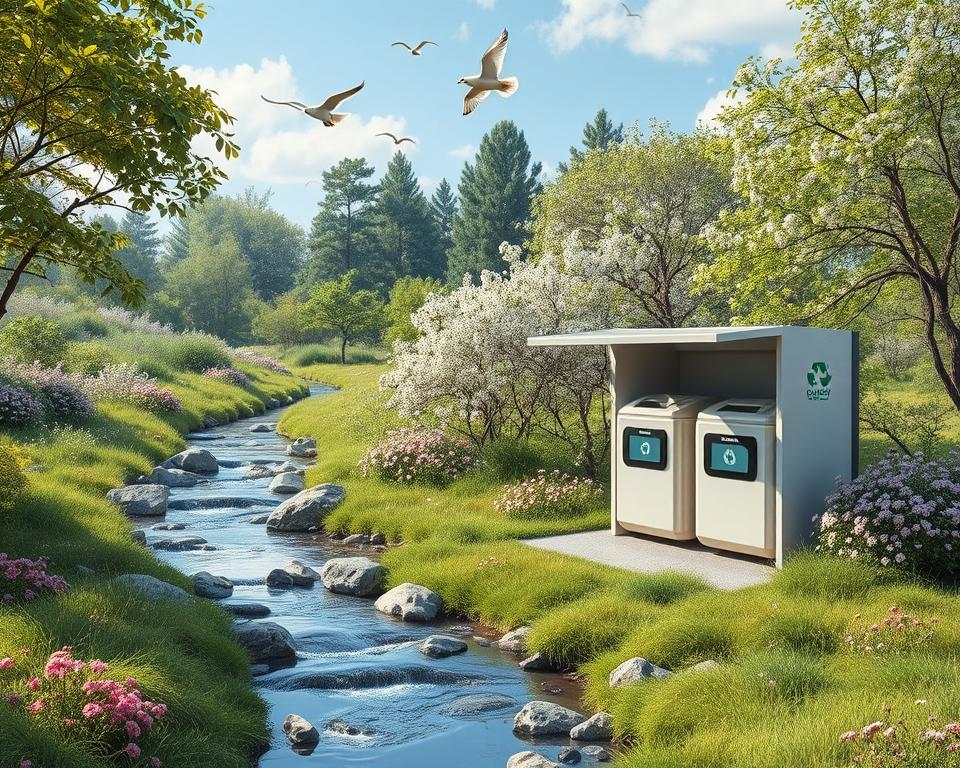Working with reclaimed wood has always touched my heart. I’ve seen wood scraps become beautiful art or useful items. But, I also know we must dispose of timber responsibly to protect our planet. In this article, we’ll look at ways to handle timber waste that are good for the environment.
Handling timber waste right is key to keeping our ecosystems healthy. By managing timber waste wisely, we can help our planet. Let’s explore dispose timber, wood waste disposal, timber recycling, and more eco-friendly solutions together.
Understanding the Need for Sustainable Timber Disposal
Proper timber disposal is key for a green future. Bad handling of wood waste harms the environment. But, good timber disposal brings many benefits.
Environmental Impact of Improper Wood Waste Management
Bad timber waste management can harm the environment. It can release harmful chemicals and add to landfill waste. Untreated wood scraps can also release methane, a strong greenhouse gas.
Also, disposing of treated or painted wood wrong can pollute soil and water. This hurts ecosystems and human health.
Benefits of Responsible Timber Disposal Practices
Good timber scrap handling and wood byproduct management have many benefits. It cuts down on timber waste in landfills. This saves natural resources and supports a circular economy.
Sustainable timber disposal also protects ecosystems and communities. It reduces the harm from forest product waste processing.
Moreover, it can turn waste into valuable resources like biofuels and compost. This reduces landfill waste and creates jobs. It helps us move towards a greener future.
Sorting and Separating Different Types of Wood Waste
Sorting and separating wood waste is key to responsible wood waste disposal. It makes sure each type is handled and disposed of in an eco-friendly way. Let’s look at the different wood waste types and how to manage them well.
Untreated Lumber
Untreated lumber, like wood from construction or furniture, can be recycled or reused. It’s free of harmful chemicals, making it safe for alternative uses.
Treated Wood
Treated wood, made to last longer, needs special care. It’s used outdoors and may have chemicals harmful to the environment. Proper timber scrap handling and disposal are key to protect our ecosystem.
Wood-Based Composites
Wood-based composites, like plywood and particle board, are harder to recycle. They mix wood with other materials, making disposal tricky. It’s important to remove and separate them carefully for proper disposal or recycling.
| Wood Waste Type | Characteristic | Disposal Considerations |
|---|---|---|
| Untreated Lumber | Natural wood free of harmful chemicals | Can be recycled or repurposed |
| Treated Wood | Contains preservatives that can be hazardous | Requires special handling and disposal |
| Wood-Based Composites | Made from a combination of wood and other materials | Challenging to recycle or repurpose |
By sorting and separating wood waste, we can dispose of it responsibly. This step helps us find the best lumber disposal and recycling options. It’s a big step towards reducing our environmental impact.
Dispose Timber: Reuse and Repurpose Options
When we dispose of timber, the best way is to reuse and repurpose it. This approach helps reduce environmental harm. It turns waste into something valuable.
Creative Ways to Repurpose Timber Scraps
Timber can be used in many DIY projects and household items. Here are some ideas:
- Constructing outdoor furniture, such as benches, planters, or garden trellises
- Creating rustic home decor, like shelves, picture frames, or wall art
- Building functional items like birdhouses, toolboxes, or cutting boards
- Upcycling timber into unique lighting fixtures or storage solutions
Selling or Donating Reusable Wood Materials
If you have extra timber, think about selling or donating it. This helps reduce wood waste disposal. It can also make money or help charities.
You can sell it online, to local woodworkers, or construction companies. Or donate it to schools, community groups, or DIY workshops. They might need it for their projects.
By finding creative ways to reuse timber, we help the environment. This approach makes dispose timber and wood byproduct management more sustainable.
Timber Recycling: Turning Waste into Valuable Resources
Timber recycling is key to reducing our environmental footprint. It turns wood waste into useful products, keeping it out of landfills. This process creates new uses for timber, wood waste, and lumber, like particleboard and biofuels.
Recycling Processes for Different Wood Products
Recycling forest product waste uses various methods. Each is designed for specific types of wood. Here are some:
- Chipping and Grinding: Wood waste is broken down into smaller pieces for further use.
- Separation and Sorting: Different wood types and contaminants are separated for efficient recycling.
- Thermal Decomposition: High temperatures turn wood waste into biofuels and chemicals.
- Mechanical Reconstitution: Wood fibers are reformed into products like particleboard.
These recycling methods help reduce landfill waste. They also bring economic and environmental benefits to businesses and communities.
Composting and Mulching Untreated Wood Waste
Composting and mulching untreated wood waste are great ways to handle wood waste. They turn waste into something useful, helping our planet. These methods help us use resources better and reduce waste.
Composting breaks down wood waste into soil that’s full of nutrients. This soil is perfect for gardens and farms. It’s a smart way to use wood waste.
Mulching uses wood chips to keep soil moist and control weeds. It’s a natural way to improve soil health. It’s good for the environment and helps plants grow better.
Using composting and mulching helps us live more sustainably. They keep waste out of landfills and give us useful resources. These practices make our environment healthier and more circular.
Safe Disposal Methods for Treated and Painted Wood
Disposing of wood waste needs special care, especially for treated and painted timber. These woods have harmful chemicals that can harm the environment if not disposed of right. It’s important to know how to handle wood waste disposal and timber waste treatment safely for everyone and the planet.
Handling Hazardous Wood Waste Responsibly
Treated and painted wood waste is dangerous because of chemicals like preservatives and paints. To dispose of it safely, follow these steps:
- Keep treated and painted wood separate from untreated wood.
- Don’t burn treated or painted wood because it can release toxic fumes.
- Call your local waste management to find out how to dispose of it safely.
- Look into recycling options, like sending it to a place that can safely reuse it.
By doing these things, you help reduce the harm to the environment and support sustainable timber disposal.
| Disposal Method | Suitability for Treated/Painted Wood |
|---|---|
| Landfill | Allowed, but requires special precautions |
| Incineration | Not recommended due to toxic emissions |
| Recycling | Preferred option, as it recovers valuable resources |
| Composting | Not suitable for treated or painted wood |
Remember, taking care of timber waste treatment and disposal is key to protecting our environment and health. By following these guidelines and choosing eco-friendly options, you help make the future greener.
Local Regulations and Guidelines for Timber Disposal
As a homeowner or business owner, knowing local rules for wood waste, timber scraps, and wood debris is key. These rules help keep our environment safe. They make sure timber disposal doesn’t harm nature.
We’ve put together a detailed guide to help you understand sustainable timber disposal:
- Learn about your area’s waste management rules. They cover how to sort wood waste, disposal methods, and what can’t be burned or thrown away.
- Look into local recycling and reuse programs for wood waste and debris. Many places have special services or spots for people and businesses to dispose of timber scrap the right way.
- Know how to handle treated or painted wood waste safely. It might have harmful chemicals. Following the right disposal steps is important for the environment and people’s health.
- Keep up with changes in wood debris removal rules. Laws can change as new environmental issues arise or as technology improves.
By following local rules and staying updated, you help make sustainable timber disposal a reality. This reduces the harm wood waste can cause in your community.
Sustainable Forestry Practices and Their Role in Timber Waste Reduction
Sustainable forestry is key in cutting down timber waste. It promotes eco-friendly wood byproduct management. By using efficient harvesting and maximizing resources, the forestry industry lessens environmental harm. It also supports a circular economy.
Holistic tree usage is a core part of sustainable forestry. It aims to use the whole tree, not just the main logs. This way, branches, leaves, and stumps are also used, reducing waste and recycling more.
Waste-conscious processing is another vital strategy. Sawmills and wood processing facilities use new technologies to cut down on waste. They optimize cutting, use lean manufacturing, and find creative uses for wood scraps.
| Sustainable Forestry Practice | Benefits for Timber Waste Reduction |
|---|---|
| Holistic Tree Usage | Maximizes resource utilization by repurposing all parts of the tree, reducing overall waste |
| Waste-conscious Processing | Minimizes the generation of wood byproducts during manufacturing, leading to more efficient and sustainable operations |
| Responsible Harvesting Techniques | Selectively harvests trees, maintains forest health, and ensures long-term sustainability of timber resources |
By adopting sustainable forestry, the industry can greatly reduce timber waste. It also supports the sustainability of timber recycling and wood byproduct management. This approach makes the system more circular and environmentally friendly.
Conclusion
We’ve looked into why we need to dispose of timber in a green way. We’ve seen how bad wood waste management is for the planet. And we’ve found many ways to handle timber waste that are good for the earth.
Sorting wood helps us find new uses for it, turning waste into something useful. Recycling and composting wood waste helps reduce landfill problems. And using safe ways to get rid of treated wood keeps our environment safe.
As we aim for a greener future, we must follow the rules of dispose timber, wood waste disposal, timber recycling, and sustainable timber disposal. By doing what we’ve talked about, we can all help lessen the harm wood waste causes. And we’ll keep our planet healthy for future generations.
FAQ
What are the environmental consequences of improper timber disposal?
Improper timber disposal harms the environment. It releases harmful chemicals into soil and water. It also adds to landfill waste and depletes natural resources.
What are the benefits of adopting responsible timber disposal practices?
Adopting responsible timber disposal practices has many benefits. It reduces waste, conserves natural resources, and supports a circular economy.
How should I sort and separate different types of wood waste?
It’s important to sort and separate wood waste correctly. This includes untreated lumber, treated wood, and wood-based composites. It ensures proper handling and disposal.
What are some creative ways to repurpose timber scraps?
Timber scraps can be repurposed in many creative ways. You can use them for DIY projects, making furniture, or selling/donating them to others.
How can timber waste be recycled into valuable resources?
Timber waste can be recycled into valuable resources. This includes particleboard, wood-plastic composites, and biofuels.
What are the benefits of composting and mulching untreated wood waste?
Composting and mulching untreated wood waste has benefits. It creates nutrient-rich soil amendments and reduces landfill waste.
How should I handle and dispose of treated and painted wood waste?
Treated and painted wood waste contains hazardous chemicals. It’s crucial to follow safety precautions and regulations for its disposal.
Where can I find information on local regulations and guidelines for timber disposal?
Knowing local regulations and guidelines for timber disposal is important. It ensures responsible management of these materials.
How can sustainable forestry practices contribute to the reduction of timber waste?
Sustainable forestry practices help reduce timber waste. They include efficient harvesting, minimizing waste during processing, and using the entire tree.





